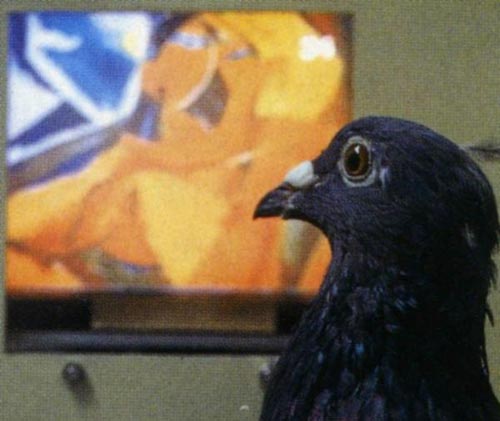Pigeons are able to perceive superior to 3-year-old children
Scientists at Keio University have shown that pigeons can distinguish their own video images, even with a latency of about 5-7 seconds, so their self-awareness is higher than a child. 3-year-old children are often difficult to identify themselves with just 2 seconds late.
Professor Shigeru Watanabe of Keio University's Human Relations Graduate School, along with Keji University, and Kohji Toda, a graduate student of Tsukuba University, trained pigeons to distinguish themselves in real-time using mirrors. and video tape. They proved that pigeons can recognize images that reflect their own movements.
Self-recognition is found in large vertebrate species like chimpanzees, a recent finding that dolphins and elephants also have this ability. The existence of the ability in pigeons shows that intelligence such as self-recognition ability also occurs in many animals, not only limited to vertebrate or dolphin species, which have brains great.

Scientists at Keio University have shown that pigeons are able to distinguish their own video images, even with a latency of about 5-7 seconds, so their self-awareness is higher than one. a 3-year-old child often has difficulty identifying himself with just 2 seconds late.(Photo: Keio University)
Methods and results of experiments
Pigeons are trained to distinguish two types of video images by the following method. First, the researchers projected a direct image of it at the present time (A) and the recorded image of the moving pigeon differs from the current image (B). When the dove learns to distinguish two types of images, the image (A) is projected with a time delay, so the screen projects the image of the pigeon a few seconds earlier. If the dove still remembers its own movement, it can recognize the image itself a few seconds late.
The pigeon can distinguish the difference between (A) a few seconds late and (B). This shows that the pigeon distinguishes the present self image and the self-recorded image of the past, meaning that it has the ability to self-awareness. The image (A) matches its movement, while (B) does not. The ability to distinguish these two types of images indicates that the pigeon understands the difference between self-movement and recorded movements. In the experiment, it was the dove's movement that caused people to question, not the level achieved in Gallup's test (see explanation at 2- (1) below). The delay in projecting the image of the longer the pigeon itself, the pigeon's ability to discriminate is further interrupted, which also indicates that the pigeon distinguishes the image by its own movements. The important thing is whether it understands the difference between movement in the video image that matches and does not match its own movement.
Methods of testing self-awareness in animals
(1) Gallup's mirror test (self-awareness test)
Self-awareness test on animals using mirrors by psychology professor Gordon Gallup Jr. At New York University, Albany developed. His paper, published in 1970 in Science, explains how chimpanzees have self-awareness. This is the first test of self-awareness in animals. He anesthetized chimpanzees and then marked their faces. When the chimpanzees wake up, they are placed in front of the mirror and they touch the corresponding marked area on their faces. Most self-recognition tests are transformations of the Gallup test, which are used to assess self-awareness in many different species. It is also called check mark, or chalk test.
(2) Evaluate the ability of self-awareness in pigeons
Self-awareness can be assessed by cross-matching. A good example for cross-joints is waving when you see yourself in a video. With the mirror image or in someone's video, when the information of the organ is inferior (how the person's hands and feet move) and visual information is correlated, it can be considered Self-awareness. Gallup's markup test is based on a prerequisite that the subject can touch themselves. If the object does not touch itself, it cannot be affirmed that it has self-awareness. However, the test performed on pigeons obtained much more progress, based on the movements of the pigeons. By remembering the projected image, the pigeon proves that they are self-aware.
Self-awareness of pigeons is higher than that of a 3-year-old.
Many experiments show that pigeons recognize by sight very well. For example, a study at Harvard University demonstrated that pigeons can identify different images of humans. At Professor Shigeru Watanabe's lab, pigeons can distinguish the paintings of one artist (such as Van Gogh) from another artist (eg Chagall).
In addition, pigeons can distinguish other pigeons at the same time being able to distinguish between stimulating dove and normal pigeons. In this experiment, pigeons can distinguish images that reflect their movements with 5 to 7 seconds of delay and images that do not reflect their movements. This ability is higher than a 3-year-old child. According to a study by Professor Hiraki of the University of Tokyo, 3-year-old children have difficulty recognizing their own images with 2 seconds late.
Refer
Toda et al. Discrimination of moving video images of self by pigeons (Columba livia). Animal Cognition, 2008 DOI: 10.1007 / s10071-008-0161-4
- Learn about the existence of billions of birds
- Birds have lions like lions
- Moscow was shaken by the pigeons 'live zombie'
- Beautiful picture: Lion pigeons' pose
- Treat 'vinegar' in children
- The most expensive pigeon in the world
- Pigeons create meteor shower across New York
- The 'drunk' pigeon hung up the tree branch to become the bird of the year in New Zealand
- Young children can distinguish language from when they cannot speak
- Pigeons smell the air to find their way
- Scary finding: Deformed dove feet in urban areas
- Use pigeons to measure air pollution levels
 Animal 'suffering' after hibernation
Animal 'suffering' after hibernation Why do goats climb well?
Why do goats climb well? Scientists were surprised to see chimpanzees eating turtles
Scientists were surprised to see chimpanzees eating turtles Giant catfish died deadly due to drought in Thailand
Giant catfish died deadly due to drought in Thailand